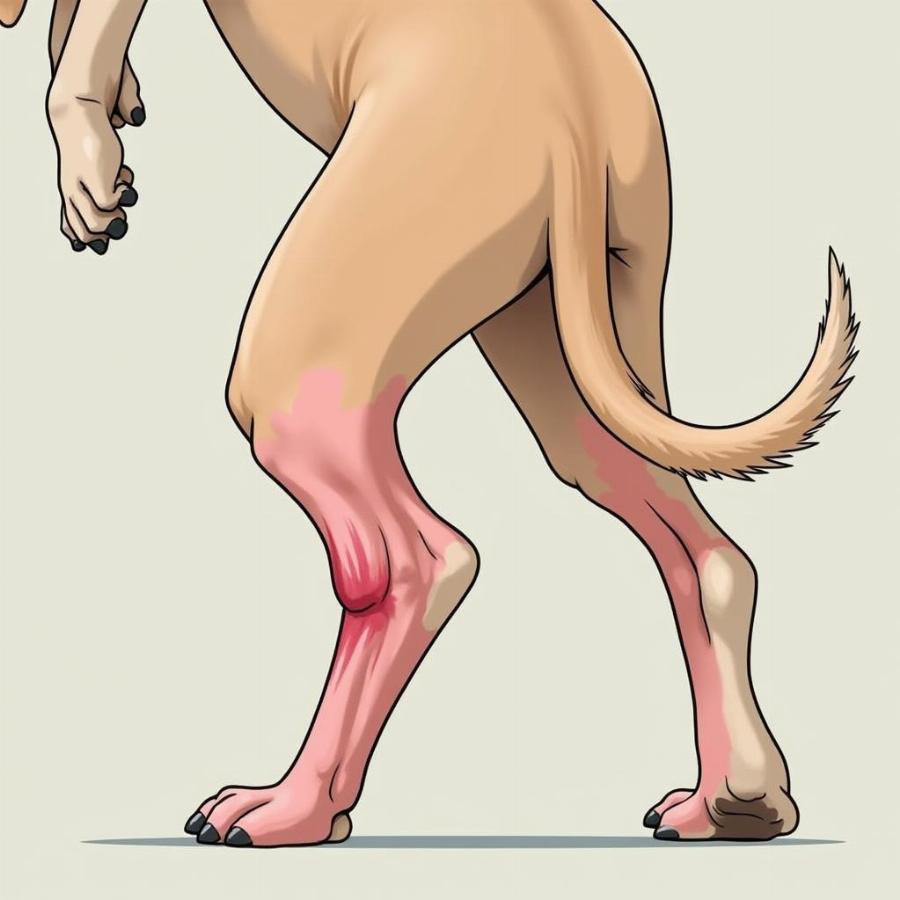Understanding the anatomy of a dog’s knee joint, also known as the stifle joint, is crucial for any responsible dog owner, especially those with breeds prone to knee problems. A healthy stifle allows our canine companions to run, jump, and play without pain. Knowing how this complex joint functions can help you recognize potential issues early on and provide the best possible care for your furry friend.
Decoding the Dog Knee Joint: A Closer Look
The dog knee joint, unlike the human knee, isn’t a simple hinge. It’s a complex structure of bones, ligaments, tendons, and cartilage working together to facilitate movement and stability. This intricate design makes the stifle susceptible to injuries and degenerative conditions. Let’s break down the key components of this crucial joint.
The Bones: Foundation of the Stifle
Three main bones form the dog’s stifle: the femur (thigh bone), the tibia (shin bone), and the patella (kneecap). The femur and tibia meet to form the main joint, while the patella slides in a groove on the femur, aiding in leg extension.
Ligaments: Holding it All Together
Ligaments are tough, fibrous tissues that connect bones to each other, providing stability to the joint. The cranial cruciate ligament (CCL) and caudal cruciate ligament are key stabilizers within the dog’s stifle, preventing excessive forward and backward movement of the tibia relative to the femur.
Cartilage and Meniscus: Cushioning the Impact
Cartilage covers the ends of the bones within the joint, providing a smooth, low-friction surface for movement. The menisci, C-shaped pieces of cartilage, act as shock absorbers and further enhance joint stability.
Common Knee Problems in Dogs
Understanding the knee surgery for dog becomes easier with a basic grasp of the anatomy. Several issues can affect the dog knee joint, including:
- Cranial Cruciate Ligament (CCL) Rupture: This is the most common knee injury in dogs, often caused by sudden twisting or trauma.
- Patellar Luxation: This condition involves the kneecap slipping out of its groove, causing lameness and pain.
- Arthritis: Degenerative joint disease that can affect the stifle, leading to stiffness and discomfort.
How can I tell if my dog has a knee problem?
Signs of knee problems in dogs can vary but often include limping, stiffness, swelling, difficulty rising, and decreased activity.
What should I do if I suspect my dog has a knee injury?
If you notice any signs of knee problems, consult a veterinarian immediately. Early diagnosis and treatment are crucial for managing knee conditions and improving your dog’s quality of life.
 Injured Dog Hind Leg
Injured Dog Hind Leg
Protecting Your Dog’s Knees: Proactive Care
While some knee problems are unavoidable, certain preventative measures can help protect your dog hind leg, especially the stifle joint:
- Maintain a Healthy Weight: Excess weight puts added stress on the joints, increasing the risk of injury.
- Controlled Exercise: Avoid excessive or high-impact activities, especially for breeds prone to knee problems.
- Supportive Surfaces: Provide non-slip surfaces at home to prevent slips and falls.
- Regular Veterinary Checkups: Early detection of knee problems can significantly improve treatment outcomes.
Conclusion: Keeping Your Canine Companion Mobile
Understanding the anatomy of a dog’s rear leg, specifically the anatomy dog knee joint, empowers you to provide the best possible care for your furry friend. By recognizing potential issues early on and taking proactive steps to protect their joints, you can help your dog enjoy a long and active life.
FAQ
- What is the most common knee injury in dogs? Cranial Cruciate Ligament (CCL) rupture.
- What are the signs of a knee problem in dogs? Limping, stiffness, swelling, difficulty rising, and decreased activity.
- How can I prevent knee problems in my dog? Maintain a healthy weight, control exercise, provide supportive surfaces, and schedule regular veterinary checkups.
- What are the treatment options for knee injuries in dogs? Treatment options vary depending on the severity and type of injury, ranging from conservative management to surgery.
- What is the stifle joint dog? It’s the equivalent of the human knee.
- Is surgery always necessary for knee injuries? Not always. Some conditions can be managed with conservative treatments like medication and physical therapy.
- How long does it take for a dog to recover from knee surgery? Recovery time varies depending on the procedure and individual dog, but it typically takes several weeks to months.
Beaut Dogs is your trusted source for all things related to canine companions, offering expert advice and resources to help you provide the best care for your beloved pet. From understanding the intricacies of the tibia in dogs to finding the perfect food and accessories, Beaut Dogs is here to support you every step of the way. When in need, reach out to us at Email: [email protected] for detailed and accurate answers to your questions from Beaut Dogs.